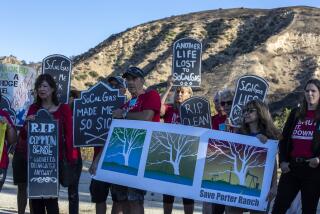Editorial: The solution to storing San Onofre’s spent nuclear fuel
- Share via
No one really likes the idea of storing spent nuclear fuel rods at the edge of the mighty Pacific Ocean, even if they are sealed in stainless steel canisters, encased in concrete and partially buried. What would happen to the millions of people living within 50 miles, or the Pacific’s marine life, if there were a leak or an accident? What would happen if California were hit with a tsunami like the one that caused the Fukushima Daiichi nuclear power plant disaster in Japan in 2011?
This is the sort of fearful speculation that has emerged since Southern California Edison revealed its plan to store spent fuel rods from the decommissioned San Onofre Nuclear Generating Station on the power plant’s grounds rather than at a federally approved nuclear waste disposal site. The reason: No such facility exists. You can thank the federal government, and Sen. Harry Reid (D-Nev.) in particular, for that.
This nation approved and built nuclear plants without ever providing a safe place for their waste to be stored.
This nation approved and built nuclear plants without ever providing a safe place for their waste to be stored, knowing all along that it would remain lethally radioactive for thousands of years. Congress settled on a site for a national nuclear waste repository — Yucca Mountain, deep in the wilderness of Nevada — but the project stalled in 2009 after the Obama administration formally opposed it. That fulfilled a promise candidate Barack Obama had made to Reid and voters in Nevada, a key swing state.
Some members of Congress are pushing to get funding as early as next year to test out privately-run temporary storage facilities for spent fuel rods. But even if lawmakers fund the projects now, it would take a decade or longer to get the sites approved and built.
This leaves no real option for San Onofre other than nuclear beach bunkers. The California Coastal Commission came to the same conclusion last month when it approved Edison’s plan to store 75 canisters on site until an off-site waste station is built. San Onofre has been storing its spent fuel rods on site without issue for decades.
Residents of Orange and San Diego counties have long had an uneasy relationship with the beachfront nuclear plant, which is perched near a coastal fault line. So community activists and environmentalists celebrated when San Onofre was officially decommissioned in 2013 after equipment troubles shut down its last two reactors.
Now that the reactors are turned off, however, the public health threat is dramatically reduced because there’s no opportunity for a catastrophic meltdown. The waste storage containers are built to withstand tsunamis and earthquakes. Still, a handful of activists aren’t satisfied and have sued to reverse the Coastal Commission’s approval. They would prefer that the spent fuel rods be packed up and shipped via truck to the Palo Verde nuclear plant in Tonopah, Ariz., in which Edison has a minority stake.
But Palo Verde’s license from the Nuclear Regulatory Commission allows the plant to store only its own spent rods, not those from other plants. Also, the Palo Verde plant is on the outskirts of Phoenix, whose residents would hardly welcome the idea. And then there’s the peril of sending trucks loaded with nuclear waste through one of the nation’s most congested freeway systems.
If a judge puts Edison’s plans on hold, it could leave the coast more vulnerable by delaying construction of the steel canisters and concrete bunkers. Right now, the spent fuel rods are being kept in cooling pools, which were intended for only temporary storage. Dry-cask storage provides more long-term protection against such risks as rising oceans and terrorism. It’s safer to pack them into canisters than to let them linger in the pools while the litigation plays out.
If San Onofre opponents want to hasten the departure of the fuel rods, they should instead lobby federal lawmakers to open Yucca Mountain. They could also throw their support behind legislation by Sen. Dianne Feinstein (D-Calif.) and other senators that would lay out a comprehensive plan for storing waste from the country’s decommissioned nuclear energy plants. The bill’s prospects are unclear, as it has yet to be heard in the Senate Natural Resources Committee.
In Congress, the safe disposal of nuclear waste apparently doesn’t rank as a priority. That won’t change until enough concerned Americans demand better solutions to the problems posed by reactors’ highly radioactive trash.
Follow the Opinion section on Twitter @latimesopinion and Facebook
More to Read
A cure for the common opinion
Get thought-provoking perspectives with our weekly newsletter.
You may occasionally receive promotional content from the Los Angeles Times.










